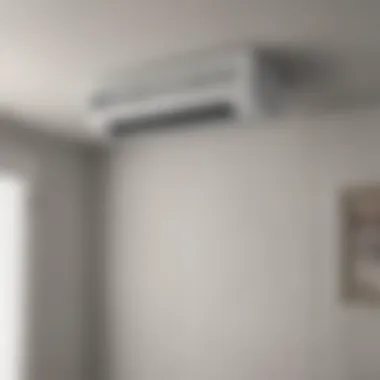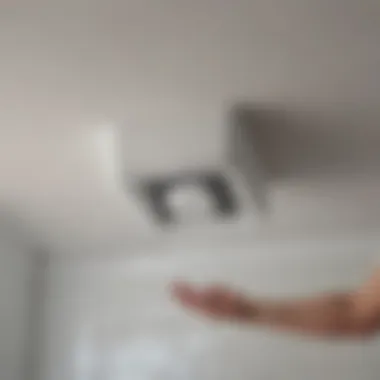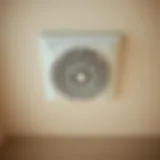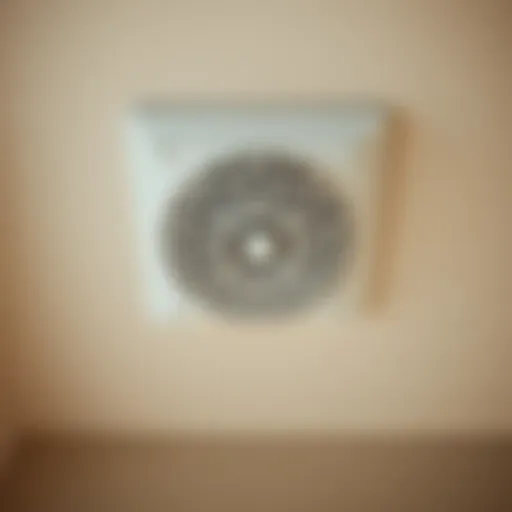Ductless Bathroom Fans: Efficient Ventilation Solutions


Intro
Bathroom ventilation is a crucial aspect of maintaining high indoor air quality and ensuring the overall comfort of one’s home. Unfortunately, traditional ducted systems are often cumbersome and can require significant installation effort and costs. In recent years, there has been a noticeable shift towards ductless bathroom fans. These fans offer a myriad of advantages, including energy efficiency, ease of installation, and enhanced air quality. This article aims to dissect the intricacies of ductless bathroom fans, providing homeowners with valuable insights about their functionality, benefits, and selection.
Current Trends
Color Palettes
One of the most appealing aspects of ductless bathroom fans is their ability to complement modern bathroom designs. Homeowners are increasingly gravitating towards neutral tones such as whites, greys, and soothing pastels. These versatile color palettes create inviting and relaxing spaces, allowing fans to blend seamlessly into various bathroom aesthetics. Incorporating ductless fans in these color schemes not only upgrades functionality but also enhances the overall visual appeal of the bathroom.
Popular Styles
Ductless bathroom fans are available in a wide variety of styles. Popular options include:
- Minimalist designs that maintain a simple and sleek look.
- Decorative models with additional features like lighting.
- Smart fans that integrate with home automation systems.
Each style serves different needs and preferences, ensuring that homeowners can find a fan that resonates with their individual taste.
"The beauty of ductless fans lies in their ability to enhance both functionality and modern decor."
Types of Ductless Bathroom Fans
There are several types of ductless bathroom fans available on the market:
- Wall-mounted fans: These are the most common type, capable of adjustable airflow directed where it is needed.
- Ceiling-mounted fans: Ideal for smaller bathrooms where wall space is limited.
- Bluetooth-enabled fans: Offer functionality with convenient sound streaming options.
Each type has unique features that can significantly improve bathroom air quality. The choice depends largely on individual preferences and the layout of the bathroom.
Benefits of Ductless Fans
Ductless fans come with numerous benefits:
- Energy Efficiency: These fans use less energy compared to traditional ducted systems, helping to lower utility bills.
- Easy Installation: They usually require minimal effort to install, often not needing professional help.
- Improved Air Quality: By circulating air efficiently, these fans reduce moisture build-up, which can lead to mold.
- Quiet Operation: Many ductless fans are designed to operate quietly, providing comfort without disruptive noise.
Installation Considerations
When considering the installation of a ductless fan, there are some important factors to evaluate:
- The size of the bathroom relative to the fan's airflow capacity.
- Electrical requirements and whether the existing wiring can accommodate the fan.
- Location for optimal airflow and convenience.
Proper installation is essential to fully utilize the efficiency and benefits that ductless fans provide.
Maintenance Tips
Maintaining ductless fans is relatively straightforward but crucial for long-term performance. Here are some tips:
- Clean the fan blades regularly to ensure maximum airflow.
- Check filters and replace them as needed to maintain air quality.
- Inspect wiring and connections periodically to preempt electrical issues.
By following these steps, homeowners can prolong the lifespan and efficiency of their fans.
Culmination
Ductless bathroom fans present a practical solution for homeowners seeking efficient ventilation options. With a range of styles and benefits that improve air quality and energy efficiency, these fans have become a significant trend in modern bathroom design. Sound understanding of the installation and maintenance considerations will ensure that these systems operate optimally. The shift from traditional ducted systems to ductless alternatives aligns with current preferences for ease, efficiency, and aesthetic compatibility, making them a commendable choice for any bathroom.
Understanding Bathroom Ventilation
Ventilation in bathrooms serves a crucial role. It ensures that air circulates properly, allowing moisture to escape. This is essential, especially in confined spaces where humidity levels can rise significantly after showers or baths. Understanding bathroom ventilation is not just about comfort; it also impacts the longevity of the fixtures and also the health of the occupants. When humidity is controlled, the risk of mold and mildew decreases. This can help prevent allergies and other respiratory issues that arise from poor indoor air quality.
Importance of Proper Ventilation
Proper bathroom ventilation aids in several vital areas:
- Humidity Control: Effective ventilation removes excess moisture quickly. This reduces the likelihood of water damage, both to the bathroom itself and to adjacent areas.
- Health Benefits: When air circulates well, it minimizes the chances of mold growth. Mold is not just an unsightly problem; it can also lead to serious health issues, including asthma and other allergic reactions.
- Comfort: A well-ventilated bathroom makes the space more comfortable to use. Nobody enjoys lingering musty odors or feeling trapped in humidity.
Thus, it becomes clear that proper ventilation is not merely an option. It is a necessity for modern bathrooms.
Consequences of Poor Ventilation
On the other hand, neglecting bathroom ventilation can lead to numerous problems:
- Mold Growth: Without sufficient airflow, moisture accumulates. This creates the perfect breeding ground for mold. Once it starts, getting rid of mold can be both costly and time-consuming.
- Structural Damage: Excess moisture can damage the walls, flooring, and fixtures in the bathroom. This might lead to rot and the necessity for expensive repairs.
- Unpleasant Odors: Stagnant air tends to hold onto smells. A poorly ventilated bathroom can become a source of embarrassment in any home.


Poor ventilation not only diminishes the aesthetic appeal of a bathroom but it can also decrease its value.
Therefore, understanding the essentials of bathroom ventilation is fundamental for all homeowners. It is equally important to consider alternatives that enhance air flow, such as ductless fans, in situations where traditional ducting is not feasible.
What Is a Ductless Bathroom Fan?
Understanding what ductless bathroom fans are is crucial for homeowners seeking effective ventilation solutions without the complications of ductwork. These fans offer a range of benefits, particularly in spaces where installing ducting is impractical or impossible. In this section, we will explore their definition, functionality, and key differences from traditional ducted fans.
Definition and Functionality
A ductless bathroom fan, as the name suggests, does not require ducting to expel air from a bathroom. Instead, it works by creating airflow within the space and filtering or recycling air directly. This simplicity allows for easier installation without the need for extensive renovations.
Typically, ductless fans include features such as built-in filters that cleanse the air of odors, moisture, and pollutants. They can operate with either exhaust capabilities or as wall-mounted units that aid in overall airflow. Some models combine ventilation with heating or lighting functions, making them versatile additions to a bathroom.
The functionality of ductless bathroom fans is designed to create a comfortable environment. They help maintain a consistent temperature and reduce humidity, which can prevent damage to bathroom fixtures and limit mold growth.
How It Differs from Ducted Fans
Ducted fans rely on a system of ducts to transport air from the bathroom to the outside. This design may be effective in larger homes or areas where ducts can be easily installed. However, ducted systems often involve higher installation costs and can be cumbersome to maintain.
In contrast, ductless fans are generally more straightforward to set up. A homeowner can often take care of the installation without professional help, which can save time and money. Additionally, ductless fans do not require regular duct cleaning, which is essential for maintaining a ducted system's efficiency and hygiene.
Key Differences:
- Installation: Ductless fans are easier to install; no ductwork is needed.
- Maintenance: Ductless fans require less maintenance compared to ducted systems, without ducts that need cleaning.
- Cost: Ductless solutions are often more cost-effective in both installation and maintenance expenses.
"Ductless fans provide a practical solution for effective bathroom ventilation without the complexities of ductwork."
In summary, ductless bathroom fans provide a viable alternative for those looking for efficient air circulation without substantial renovation. They effectively address common bathroom challenges, making them a worthy consideration for homeowners.
Types of Ductless Bathroom Fans
Understanding the various types of ductless bathroom fans is crucial for homeowners seeking efficient ventilation solutions. These fans come with distinct functionalities and benefits that cater to different needs and preferences. Knowing the differences among the types is essential for making an informed choice that would enhance the overall air quality in your bathroom.
Exhaust Fans
Exhaust fans are perhaps the most recognized type of ductless bathroom fans. They are designed specifically for ventilating moist air, which is critical in preventing mold and mildew growth. Exhaust fans work by removing excess humidity generated during activities like showering or bathing. This process not only helps to maintain comfort but also protects the structure of the bathroom by preventing damage from prolonged moisture exposure.
When selecting an exhaust fan, consider the fan’s rating in cubic feet per minute (CFM). A higher CFM indicates a greater capacity to remove air, which can be beneficial in larger bathrooms. Manufacturers often provide guidelines on the ideal CFM for different room sizes, ensuring optimal performance.
Ceiling Fans
Ceiling fans can also serve as ductless ventilation solutions in bathrooms. They circulate air within the space, making it feel cooler and more comfortable. While not as effective in removing moisture as exhaust fans, they contribute to improved air movement and temperature control.
When considering a ceiling fan for the bathroom, it’s important to choose a model specifically designed for humid environments. These fans are usually rated for damp or wet locations and feature corrosion-resistant materials. Additionally, the placement of the ceiling fan can influence airflow; positioning it correctly ensures that it does not obstruct movement in the room.
Air Purifiers with Fan Functions
Air purifiers that feature fan functions offer another innovative option for managing air quality in bathrooms. These units not only help in removing allergens and particles but also provide a level of air circulation that may benefit smaller spaces where ventilation is limited. The filters in these purifiers capture dust, pollen, and other particulates, promoting clean air.
When selecting an air purifier with a fan function, check for the dimensions and specifications suitable for your bathroom size. Filters should be easily replaceable, and the noise levels should be acceptable since bathrooms often need steady airflow without disruptive sounds.
In summary, choosing the right type of ductless bathroom fan can significantly enhance ventilation, control humidity, and improve air quality. Each type—exhaust fans, ceiling fans, and air purifiers—fulfills specific functions, with unique pros and cons. Recognizing these differences aids in making the best decision to suit your home’s needs.
Benefits of Ductless Bathroom Fans
Ductless bathroom fans serve as an essential element in modern ventilation solutions. Their rise in popularity is driven by their unique benefits, which cater to the needs of homeowners seeking efficient alternatives. Understanding these benefits is crucial for making informed decisions about bathroom ventilation. Below are some key advantages of ductless bathroom fans:
Energy Efficiency
Ductless bathroom fans offer significant energy savings compared to traditional ducted systems. By not requiring extensive ductwork, these fans can be installed in areas where airflow and energy loss can be minimized. They operate on lower wattage and are designed to provide adequate ventilation without consuming excess energy. This aspect is particularly appealing for house owners who wish to reduce their utility bills while maintaining a healthy indoor environment.
Additionally, many ductless fans come equipped with energy-efficient motors. These motors are engineered to use less power while delivering high performance. For individuals keen on sustainability, investing in a ductless fan can represent an eco-friendly choice that aligns with conservation goals.
Ease of Installation
The installation process for ductless bathroom fans is often straightforward and less time-consuming than ducted alternatives. Unlike ducted fans, which necessitate complex routing of ductwork through walls or ceilings, ductless models typically require only a few connections and mounting points. This simplicity translates to lower labor costs and reduced disruption during installation.
Even homeowners with basic handyman skills can often install these fans themselves. Most models come with detailed instruction manuals, making it feasible for many to attempt DIY installation. However, ensuring proper placement and electrical connections would still benefit from professional assistance for optimal results.
Reduced Noise Levels


Noise is a common concern with home ventilation systems. Ductless bathroom fans generally operate at lower decibel levels compared to their ducted counterparts. Their design focuses on quieter operation, which is a critical feature for bedrooms and other living areas adjacent to bathrooms.
Many models incorporate noise-reducing technology that isolates the sound of the fan motor from the living space. This allows for comfortable use without distracting from daily activities. The ability to maintain a peaceful home environment is a benefit that resonates strongly with families, especially those with children or in shared living spaces.
"A lower noise level not only enhances comfort but also contributes positively to overall well-being in the home."
In summary, the benefits of ductless bathroom fans encompass energy efficiency, ease of installation, and reduced noise levels. These factors collectively highlight their potential as a valuable asset in enhancing bathroom air quality while addressing specific homeowner needs. As such, they present a pragmatic choice that balances functionality with convenience.
Installation Considerations for Ductless Fans
When it comes to adopting ductless fans for bathroom ventilation, careful installation considerations can significantly influence the overall effectiveness of the unit. A well-installed ductless fan can lead to improved air quality, energy efficiency, and user satisfaction. Without a proper installation strategy, even the best product may underperform, creating a myriad of issues such as inadequate air removal or increased energy consumption. This section explores essential elements to consider during the installation process, including site assessment, electrical requirements, and optimal fan placement.
Site Assessment
Before any installation, conducting a thorough site assessment is crucial. This involves evaluating the current bathroom layout, humidity levels, and existing ventilation options. Each bathroom has unique characteristics that influence fan performance. Measure the square footage and analyze the average humidity produced during showers or baths. Some bathrooms may have windows or other openings, affecting how the fan operates. If the bathroom experiences high humidity levels, a robust ductless fan may be more necessary compared to those with standard moisture levels.
A strategic site assessment ensures the selected fan operates efficiently and meets the needs of the space without unnecessary energy waste.
Electrical Requirements
Understanding the electrical requirements is fundamental when installing ductless fans. Most fans will need a power source that meets their specific voltage and wattage needs. Verify the electrical layout of your home and make any necessary upgrades to support the new fan. Also, consider compliance with all local electrical codes to avoid hazards. If the fan has integrated lighting or smart technology features, ensure there is enough capacity in the circuit to handle these additional components without overloading.
Optimal Placement
The location where the ductless fan will be installed plays a significant role in its efficiency. Optimal placement typically means positioning the fan as close to the source of humidity as possible. For example, installing the fan near the shower or bathtub can effectively capture moisture before it spreads throughout the bathroom. Additionally, consider the height at which the fan is mounted, typically at least eight feet from the floor, to maximize its performance. Avoid placing the fan in corners or areas where airflow is restricted, as this can lead to poor performance and non-compliance with ventilation standards.
By taking these installation considerations seriously, you can ensure that your ductless fan operates optimally and enhances both the air quality and energy efficiency of your bathroom.
Air Quality and Health Implications
Understanding air quality and health implications is critical when dealing with bathroom ventilation systems. Poor air quality can lead to a variety of health issues, particularly in spaces like bathrooms that are prone to moisture buildup and limited airflow. Ductless bathroom fans, designed to improve air circulation and reduce humidity, serve an essential role in this context.
Humidity Control
Humidity control directly affects indoor air quality. High humidity levels can foster an environment for dust mites, allergens, and respiratory irritants. These negative elements can have adverse effects on health, especially for individuals with asthma or allergies.
Ductless bathroom fans help maintain optimal humidity levels by effectively removing excess moisture from the air. They can operate independently of traditional ducting systems, making them suitable for smaller spaces where duct installation may not be feasible. For instance, a bathroom fan can sense moisture levels and adjust its operation, ensuring that humidity stays within a healthy range. Regular operation of these fans can significantly enhance the living conditions of any household.
Mold Prevention
Mold thrives in environments with excessive moisture. Bathrooms, often lacking adequate ventilation, are commonly affected. The presence of mold not only makes bathrooms unsightly but also poses serious health risks, including respiratory issues and skin allergies.
Utilizing ductless bathroom fans can aid in preventing mold growth. By consistently reducing humidity and maintaining airflow, these fans eliminate the damp conditions mold needs to flourish. Owners of ductless systems should prioritize using their fans during and after activities that generate moisture, such as bathing or showering. Failure to do so can lead to increased humidity and an elevated risk of mold development.
It's crucial to recognize that effective air quality management transcends mere aesthetics; it directly impacts the health and well-being of all occupants.
Choosing the Right Ductless Bathroom Fan
Selecting the appropriate ductless bathroom fan is a pivotal task. Homeowners should understand that not all fans function the same way. A correct choice impacts air quality, energy efficiency, and overall comfort in the bathroom. Given the multitude of options available, being informed about specific elements is essential. This knowledge ensures a fan meets individual needs and space requirements.
Key Features to Consider
When exploring ductless bathroom fans, several key features are critical to evaluate:
- Airflow Rate: Measured in cubic feet per minute (CFM), this metric indicates how much air a fan can move. Higher CFM ratings are preferable for larger bathrooms.
- Noise Level: Generally measured in sones, this feature determines how quiet or loud a fan operates. Quieter fans are more desirable, especially in spaces where privacy is paramount.
- Energy Efficiency: Look for fans with Energy Star ratings. These fans consume less electricity while effectively circulating air, which is beneficial both for the environment and for reducing utility bills.
- Additional Functions: Some models include integrated lighting or air purification functions. Evaluate whether these features are present, as they can add convenience and enhance overall air quality.
- Design and Size: The fan should fit the aesthetic of the bathroom and also suit its physical dimensions. Compact designs may be necessary for limited spaces.
Choosing the right features will ultimately enhance your bathroom's atmosphere, making it essential to match them with personal needs.
Brand Comparisons
When it comes to ductless bathroom fans, different brands offer varying levels of performance, reliability, and design. Recognizing the distinctions can aid in making an informed decision. Here are a few notable brands:
- Broan: Known for a wide range of fan options, Broan focuses on energy efficiency and quiet operation. Their fans are often praised for effective airflow and durability.
- Panasonic: Renowned for their Whisper series, Panasonic fans are valued for their super quiet operation and higher CFM ratings. They also emphasize energy conservation.
- Delta Breez: These fans are typically energy-efficient and well-regarded for their stylish designs. They also offer a good balance between price and performance.
- Air King: A more traditional choice, Air King provides reliable performance but may not compete with the energy efficiencies of other brands. Their fans are durable and often used in high-moisture environments.
It helps to read customer reviews when comparing brands. They provide real-world feedback on performance and issues that may arise. Doing so will aid in identifying a brand that aligns with expected performance and reliability in ductless bathroom fan selection.
Maintenance of Ductless Bathroom Fans
Maintaining ductless bathroom fans is crucial for their longevity and efficiency. These fans, while convenient and effective, require regular attention to function optimally. Neglecting maintenance can lead to decreased performance, increased noise, and potential health risks from accumulated dust and moisture.


Regular Cleaning Routines
Cleaning is a fundamental aspect of maintenance for ductless bathroom fans. Dust and grime can accumulate on fan blades, grills, and filters, impacting airflow and efficiency. Regular cleaning routines help ensure the fan functions at its best.
- Frequency: Fans should be cleaned every month, especially in high-use bathrooms.
- Cleaning Process: Start by turning off the power to the fan. Use a damp cloth to wipe the exterior surfaces. For the interior, carefully remove any filters and clean them according to the manufacturer's instructions.
- Tools Required: A soft brush or cloth, a mild detergent, and possibly a vacuum cleaner for deeper cleaning.
In addition to visible surfaces, air filters need attention. Depending on the type, they can collect more debris than other parts. Some fans come with washable filters, while others may require replacements.
Signs of Wear and Tear
Recognizing the signs of wear and tear is vital to maintaining ductless bathroom fans. Early detection can prevent issues from escalating into costly repairs or replacements.
- Noisy Operation: Ductless fans should operate quietly. If noises such as grinding or buzzing occur, it may indicate a mechanical issue.
- Reduced Airflow: A noticeable decrease in airflow signals a potential blockage or mechanical failure.
- Frequent Breakdowns: If the fan frequently needs repairs, it may be time for a replacement.
Regular inspection can save money on long-term repairs.
Monitoring these symptoms will help ensure your ductless fan continues to provide effective ventilation. Keeping a maintenance log can assist in tracking cleaning, inspections, and any issues that arise.
In summary, diligent maintenance routines and careful observation of wear and tear signs can significantly enhance the performance and lifespan of ductless bathroom fans. Ensuring your home’s ventilation system works efficiently contributes to better indoor air quality and comfort.
Limitations of Ductless Bathroom Fans
Understanding the limitations of ductless bathroom fans is crucial for anyone considering these solutions for ventilation. While they come with several advantages, it is important to be aware of specific challenges and drawbacks. A clear perspective on these limitations helps homeowners make better choices tailored to their specific needs and restroom configurations.
Air Extraction Challenges
One of the primary limitations of ductless bathroom fans is their capacity for effective air extraction. Unlike ducted systems, which can expel air outside the home, ductless fans typically recirculate air within the same space. This creates a challenge in effectively removing humid air from the bathroom. Due to this recirculation, moisture can linger, especially in areas with high humidity.
Ductless fans require a careful understanding of air dynamics. Homeowners must position these fans in a way that optimally captures moist air and encourages circulation. Still, limitations persist. In very humid conditions, ductless systems may struggle to maintain comfortable humidity levels, leading to less effective ventilation overall.
Potential Cost Implications
Cost is another aspect to consider when opting for ductless bathroom fans. While installation costs may initially be lower compared to ducted systems, other potential cost implications could arise over time. The operational efficiency of ductless fans can vary depending on the model and its ability to handle humidity.
If a ductless fan is not able to effectively manage moisture levels, homeowners might face additional expenses in terms of increased energy bills or even repairs related to humidity damage. On top of that, frequent replacements or maintenance of these fans can also contribute to ongoing costs, potentially negating the perceived savings from the installation.
It is essential to balance initial savings with long-term expenses when evaluating ductless bathroom fans.
To sum up, understanding the limitations related to air extraction challenges and potential cost implications is vital. This ensures a well-informed decision when selecting the right ventilation solution. Homeowners should assess their unique situation and weigh these factors against the benefits of ductless systems for optimal results.
Future Trends in Ventilation Solutions
The evolution of residential ventilation systems is entering an exciting phase. As homeowners seek efficient and effective solutions, understanding future trends in ventilation becomes paramount. This section will delve into innovations that promise to revolutionize how we manage air quality in bathrooms. The integration of smart technology and a enhanced focus on sustainability lead the charge towards more efficient alternatives for ductless ventilation systems.
Smart Technology Integration
Smart technology is reshaping how we interact with our homes. In the context of ductless bathroom fans, smart features can greatly enhance convenience and efficiency. These fans can now be equipped with sensors that detect humidity levels and adjust accordingly. This means that the fan operates only when necessary, reducing energy consumption significantly.
Moreover, the ability to control these devices remotely via mobile apps allows for even greater flexibility. Users can monitor air quality and make adjustments even when they are not at home.
Another fascinating aspect is the compatibility with smart home systems. With integration into platforms like Google Home or Amazon Alexa, homeowners can include their ductless fans in their overall energy management strategies. For example, fans can be programmed to work in tandem with heating and cooling systems to optimize airflow throughout the house. This kind of integration not only improves comfort but also leads to noticeable energy savings.
"Smart ventilation solutions not only enhance comfort but also provide significant energy efficiencies in the long run."
Sustainability Practices
Sustainability is no longer an option but a necessity. The future of bathroom ventilation systems embraces practices that contribute to environmental responsibility. Energy-efficient ductless fans are designed to consume less electricity, making them a responsible choice for eco-conscious homeowners.
Newer models often feature technologies such as energy recovery ventilators (ERV), which allow for the exchange of stale indoor air with fresh outdoor air without wasting energy. Such systems minimize the energy lost while ensuring optimal ventilation.
Recyclable materials also play a role in the manufacturing of ductless fans. Many brands are committing to using environmentally-friendly materials that reduce the overall carbon footprint of home appliances. This shift towards sustainable manufacturing reflects growing consumer demand for products that combine functionality with environmental stewardship.
The End
The conclusion of this article serves as a critical reflection on the diverse options available within the realm of ductless bathroom fans. Understanding these options is pivotal for homeowners seeking efficient and practical ventilation solutions. It highlights how effective bathroom ventilation is not just about removing humid air; it is also about enhancing indoor air quality and promoting a healthier living environment.
Summarizing Key Points
The discussion throughout the article emphasizes several vital points regarding ductless bathroom fans:
- Importance of Proper Ventilation: Bathroom fans are essential for controlling humidity and preventing mold growth. A well-ventilated bathroom improves the overall air quality in the home.
- Types of Ductless Fans: Options include exhaust fans, ceiling fans, and air purifiers with fan functions, each serving specific needs within the bathroom.
- Benefits: Ductless fans offer advantages like energy efficiency, ease of installation, and reduced noise levels compared to traditional ducted systems.
- Limitations to Consider: Awareness of the challenges in air extraction and potential cost implications ensures homeowners make informed decisions.
Final Recommendations
For homeowners evaluating ductless bathroom fans, the following recommendations can provide guidance:
- Assess Your Space: Consider the size and layout of your bathroom. This will influence the type of fan that will function best for you.
- Evaluate Specific Needs: Determine whether you prioritize air quality, energy efficiency, or low noise levels and choose accordingly.
- Regular Maintenance: Establish a cleaning routine to ensure the longevity and efficiency of your chosen fan.
- Stay Informed: Keep updated with advancements in ventilation technology and sustainability practices that may benefit your home.
Ultimately, the right ductless bathroom fan can significantly contribute to a healthier, more comfortable living space.



